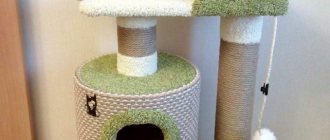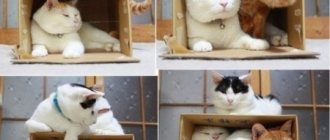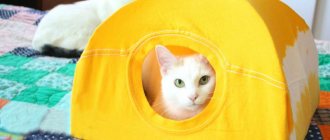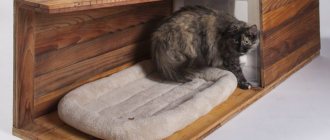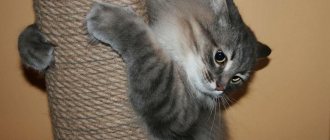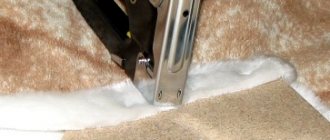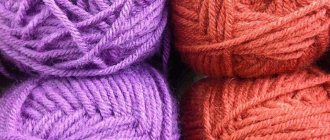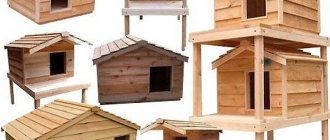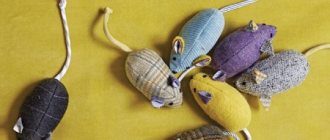We always wanted to have some kind of corner for the cat where she could jump and hide, something aesthetically pleasing, interesting for her and useful for us. As a result, inspired by the projects of other people, I made a play complex for cats with my own hands. I hope you like the climbing frame idea and also get inspired and enjoy the cute cat photos.
House for a kitten
DIY automatic cat feeder
The best house for a kitten will be one with as much entertainment as possible.
Note! When designing a home for a small kitten, it is important to consider its height so that he can climb into it.
You should not build a house for growth, in this case the animal will be uncomfortable and uncomfortable in it. Therefore, at this age, owners often prefer soft houses made from newspaper tubes or cardboard blanks. For a small pet, a regular cardboard box or a light fabric house will do.
House for a kitten
Recommended tools for assembling the structure
The set of cat furniture required for assembly may vary depending on the complexity of the product and the habits of the owner. The list of the most relevant ones is presented in the figure.
Of course, you can do without a screwdriver if you use a screwdriver. If you don't have a glue gun, you'll need to buy one. This is an extremely effective device that you will use more than once. A furniture stapler is no less convenient when assembling the product in question. Instead of a jigsaw, you can work with a hacksaw and electric drill. I would also recommend that you buy a velcro drill bit. This very economical device will help you save a lot of energy and provide rounded surfaces on your wood.
Cat shelf
To make it you will need a pine or oak board. It should be cut into shelves of the required size. Next, you should connect all the parts together using self-tapping screws or wood glue and a furniture dowel.
Cat shelf
After the wall structure is assembled, it should be examined again for nicks and irregularities. If necessary, it is recommended to clean them, after which the shelf is varnished.
Setting up the glow strip
The luminous tape is installed along the outer perimeter of the house, and the appropriate settings are made.
LED strip for a cat house
Upholstery of steps
The upholstery on the steps can be secured with special hat nails or a stapler.
Decoration of steps
For your information! A little catnip will allow the owner to attract the attention of his pet to the new design.
cat house
A cat house is a convenient and useful structure not only for the cat, but for other family members. This will allow the owner to forget about the torn wallpaper and sofas and give the cat the opportunity to relax in privacy. If there are children in the house for an animal, this is simply a necessary design.
Peculiarities
The cat house performs several functions:
- shelter - a place where you can hide from the other residents of the house;
- observation point - the pet should be able to view the maximum space around from it;
- a warm, cozy nest where you can sleep or just lie down and soak up;
- play area with scratching post , ribbons, tunnels and other play accessories.
An original house for a cat
Thus, in order to look attractive to cats, the house must be:
- according to the size of the cat - it should fit freely into it and be able to freely curl up into a ball, but it is important not to overdo it with the dimensions;
- consist as much as possible of natural materials - wood, cardboard, natural felt and others (synthetic materials electrify the fur of cats, and this causes discomfort - plastic, artificial fabrics);
- away from equipment and objects that produce loud sounds - away from TV, radio, music center;
- moderately warm, not exposed to drafts - cannot be installed under windows, on a windowsill, close to a radiator, near a door or passage.
IMPORTANT! The ideal option is to arrange a resting place for the cat in the far corner, relative to the entrance to the room or against the wall located opposite from the entrance.
Stylish cat house
The house should be the size of the pet
It is very important not to forget about humidifying the air in rooms where pets are kept. Read our separate article on how to make a humidifier with your own hands. And also, which humidifier is better to choose.
From the box
If there is any extra box in the house, you can show your imagination and construct a cardboard house yourself.
To make construction somewhat easier, use a box of suitable sizes so that your pet does not feel cramped in it. You can involve children in the work. They will be interested in feeling like builders.
Cardboard cat house
So, to make a cat house you will need:
- a box with fairly thick cardboard (you can use a Russian Post package);
- carpet or other dense but soft material;
- any water-repellent material;
- sharp knife;
- odorless glue;
- pencils, rulers and other tools for marking;
- wide tape.
Proceed to making a cardboard cat house in the following sequence:
- Mark the main entrance and back door using a pencil and compass. Cut out the holes. Let the main entrance be larger than the back door. But remember that your pet should slide through it easily.
- Tape all edges of the box that open and facilitate disassembly. For greater persuasiveness and protection, you can tape the entire box with tape.
- Further cut pieces of water-repellent material in accordance with the dimensions of the walls of the future house. Carefully bring them in through the “entrance”, lay them out, gradually gluing them to the walls with glue. It is better to use glue for a hot procedure, especially if you have already covered all the walls with tape.
- Separately glue the joints of the assembled box with water-repellent materialto keep your pet warmer.
- Now you can begin the exterior finishing. Cut pieces of carpet according to size. The front wall with the entrance is cut out in one piece, glued and only then, after thorough drying, a hole for the entrance is cut out. The hole is cut with a margin of approximately 1-1.5 cm for bending inward. Cut the edge of the carpet diagonally and glue it, “tucking” it inside the house.
- Let the house dry for at least 3 days. After the time has passed, place a pillow in the house and call the cat to rest.
Such self-production options can be slightly improved and modified. Some people prefer to glue the cardboard to fit their designed structure. There is often a multi-room or multi-level structure, which can be easily achieved with cardboard and tape.
Labyrinth of boxes
Drawing up a drawing and cutting out parts with examples
Before building a house, you need to think it through to the smallest detail, and this is where a drawing is needed. You can take a ready-made one or design it yourself. If you have no previous experience in this matter, then it is better to take drawings without complex multi-component structures.
DIY cat scratching post: options at home
When preparing a drawing yourself, you need to pay attention to:
- house dimensions. It should be only slightly larger than the pet;
- The drawing must indicate the dimensions of each part.
Note! An important condition is the size of the living space. If the area of the apartment does not allow for the construction of a large cat dwelling, then a structure equipped with a scratching post, a stand, and a hanging ball will be sufficient.
Drawings of cat houses
After all materials and tools have been prepared, you can begin cutting out parts. It is necessary to strictly follow the instructions for making a home structure.
For a plywood house, you need to cut out a rectangle with dimensions of 55×40 cm and a square of 30×30 cm with a jigsaw. Three shallow holes with d = 3 cm need to be made in the rectangular part, the structure posts will be inserted into them. One similar hole is made in the square. To make the upper part, you will need a piece of wood, from which you need to cut 2 round parts with d=40 cm. A hole with a recess should be made in the center of each.
Homemade cat house
Vertical sticks need to be cut into the required sizes: 85 cm, 120 cm, 120 cm, 173 cm. They will be inserted into the holes. The side parts are also cut out with a jigsaw, and through holes are made.
After all the parts are cut out, you should do the upholstery. To make it soft, the floor of the house is covered first with foam rubber and then with fabric. The walls are also decorated with fabric and foam rubber, everything is attached with a furniture stapler.
To strengthen the structure, it is necessary to prepare a pair of bushings; they are fixed in the center of the bases, and appropriate connectors for entry are made in the beams. This way the structure will be the most stable.
Note! Vertical beams are wrapped with hemp rope. The surface is smeared with glue and the wood wrapping begins.
Select an option
Building a house for a cat will not be difficult; it is enough to take into account a number of factors that take into account the behavior of the animal. If you approach the problem formally, then you can make a house, but it will simply take up space and gather dust. First of all, you should observe the animal to determine where the cat likes to rest. Most cats prefer to climb to heights, hiding in a secluded place, although there are some that simply rest on the floor. In this case, a lot depends on the breed of the animal.
First you need to decide on the choice of design
Design approaches
Not all cats behave the same way, so the approach can be highly individual. It is typical for cats to have two passages into the house, which is associated with the evacuation of the offspring in case of danger, although many owners castrate or sterilize their animals in a timely manner. To build a house, you can use pipes or other similar structures. However, they do not like wide openings, as this leads to a feeling of danger. In this regard, the entrance to the house should be narrow enough so that the animal can crawl into it freely. Most cats prefer heights, and in houses on the floor they can live with their offspring. If cats do not have offspring, then they will choose a larger house located at some distance from the floor, although, as mentioned above, everything is purely individual.
Cats prefer upper floors
Cats will definitely choose a higher place with a good view, as they love to watch what is happening around them. They prefer to be on platforms and are rarely seen lying in the house. For a cat, it is important that there are many areas, and of such a size that the animal can lie on them at full length. Such areas do not need to be fenced, since cats feel comfortable at heights. If owners make fences, it’s more for their own peace of mind, but cats don’t need them.
Place for a cat
If the cat does not have offspring, then cats, no less than cats, love to be on sites and watch everything that happens from above. At the same time, one should not ignore the desire of a cat, like a male cat, to sometimes retire and relax so that no one disturbs them. At the same time, it should be noted that there are breeds that are not intrusive in their behavior and try to retire. Therefore, both cats and cats need a house.
Adding some elements
The term “cat house” should be understood as a whole complex of elements with platforms and other useful additions. As a rule, animals choose the areas they like, and appear on some of them quite rarely. It is quite difficult to determine in advance which of the areas the animal will like, which is why it is necessary to build a whole complex.
Additional, but very useful elements in the cat complex are scratching posts and climbing frames. Scratching posts are vertical surfaces wrapped in ropes made from natural ingredients, while climbing frames are horizontal and inclined surfaces designed to allow the animal to move between different levels of the complex. By the way, scratching posts are also used by animals to climb onto the upper tiers or platforms.
Hammocks and claw pads
A hammock is another element that will not interfere with a cat’s complex. It is a rectangular piece of fabric that is attached to two crossbars. You can make the frame rigid and hem fabric to it, after which the frame is attached to the base at 4 corners.
As an option, it is permissible to hang toys on strings that animals simply adore and can play with for hours.
Cats simply love pipes that are made of fabric. To make the structure rigid, wire is inserted around the perimeter into the ends of the pipe. One end of the pipe should be raised to a certain height, and the second should be left on the floor. There must be a gap at the end of the pipe, otherwise the cat will ignore such an element. Animals can spend a lot of time in pipes because they feel like hunters in ambush.
Fabric pipes
Few people know that cats really like it if you take clothing brushes and attach them to a vertical surface, somewhere at the level of the animal’s back. Cats simply love to scratch themselves on these surfaces, which are made of medium-hard artificial bristles.
At what altitude
For any cat, the higher the resting place is located, the better, since in such conditions they feel safe. Therefore, in such cases, the cat house can be located even under the ceiling itself. Regardless of how many tiers there are in this complex, the top one will be mostly occupied. If there are several cats, then the leader will be located on the top “floor,” but despite this, this “floor” will remain controversial for the animals and each of the cats will want to be the first to occupy it.
Place right under the ceiling
It is believed that the smallest height of a cat's corner is one meter. A low height appears to be safe even for small kittens, but as they age, they will still move to higher tiers when they feel that they are capable of it.
Options for walls
The best option is to place a seating area on the wall, since it can take up about 1 square meter on the floor. Considering our apartments, where every square meter counts, a place for a cat on the floor is quite problematic, but placing it on the wall is not a problem at all, just secure it properly. Several platforms can be secured and connected by transitions from boards, placing them at different angles. As an option, you can use rope ladders, which the animals will certainly enjoy. In other words, there is a huge field for imagination, but at the same time you also need to have desire.
Wall options
Such elements are also called shelves for cats, since they are quite similar to shelves for books, since their fastening is identical. Cats and cats happily exploit such feline complexes.
Preparing the necessary materials
How to make a house for a cat with your own hands: patterns
To make a cat house you will need the following materials:
- pine or plywood boards;
- steps (30 cm by 120 cm)
- birch plywood 50 cm by 50 cm;
- poplar board 7 mm by 7 cm;
- oak dowel;
- carpet 100 cm;
- upholstery;
- foam;
- screws for connection;
- shelf brackets;
- LED Strip Light;
- wiring.
Construction materials
Construction materials
Most often, leftover building materials are used to build a house. When choosing them, you should pay attention to the absence of a strong odor, in addition to the smell of wood itself. The material should not be electrified; it is better to avoid silk. The following building materials are used: plywood, chipboard sheets, thin boards, rods, newspaper tubes.
The vertical or inclined part can be made from a plastic sewer or paper pipe, a tree trunk, or a wooden beam. The inclined part is also decorated with boards, chipboard or fabric. A hammock is usually constructed from rope and thick fabric. The site is built from wood, chipboard, plywood.
Note! Wood is not sheathed, but plywood and chipboard must be covered with fabric. You can also use a ready-made strong branch and use it to create an unusual house for your pet.
Types of houses for cats
Beginning of work
A DIY climbing frame for cats made from a tree branch will be a wonderful and unusual addition to the interior, the main thing is to find a suitable tree. It needs to be firmly secured where the cat house will be built. The cut branches of the tree will become the places where the shelves will be located.
Important! One of the shelves must be located at the top, as animals love to climb high.
Preparing the necessary materials
Rope bridge
Step-by-step instructions for creating:
- Divide the poplar leaf into 6 parts.
- Coat each piece with varnish or a mixture of tung oil and wax.
- Wait until completely dry.
- Stack all the pieces on top of each other and drill the corresponding holes using a drill.
- To connect, you can use either nuts or wooden beads. Connect the parts and attach to the cat house.
Making a rope bridge
Cutting parts
When making a wooden cat climbing frame with your own hands, you should use a jigsaw to cut all the parts, measure the vertical and inclined “pillars” to the required size, and also saw off the excess. Next you need to prepare the base and side parts.
How to cut parts
Connections
In order for the cat house to be strong, appropriate holes should be made in the beams and bushings should be inserted into the base. In addition, it is better to secure the side parts not with small nails, but with self-tapping screws.
Making connections
Gluing the main structure
After all the parts are prepared and connected to each other, you can begin upholstering and varnishing the house. The corners must be carefully glued so that there are no gaps.
Gluing parts of the structure
The assembled rope bridge must be connected to the main structure. To do this, securely fasten it at the very entrance to the house and on the opposite shelf.
Rope bridge
Making a cat climbing frame
Step-by-step instructions for creating:
- Make a diagram with the dimensions of each part.
- Prepare the necessary building materials.
- Cut each piece to size.
- Connect all the parts together.
- Cover with varnish or decorate with fabric upholstery.
- Add additional entertainment elements: tunnel, rope, bridge, hammock, slide, wheel.
Construction connection
